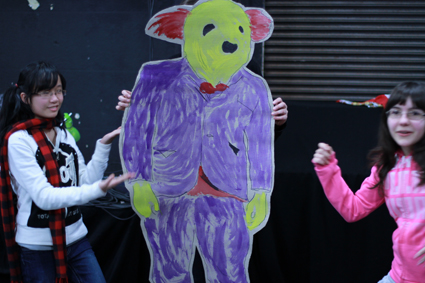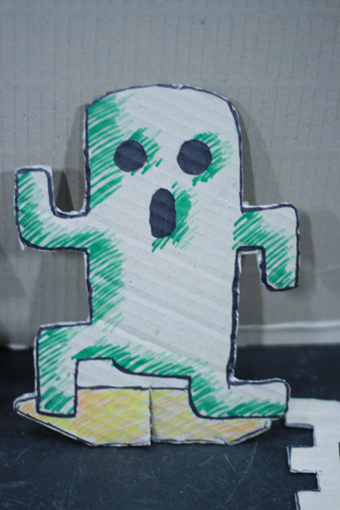amazing maze
oliver downes: shopfront, arcade assembly

Arcade Assembly, Shopfront Contemporary Arts & Performance
photo Pollyanna Nowicki
Arcade Assembly, Shopfront Contemporary Arts & Performance
MAZES GET A BAD RAP. PRACTICALLY SYNONYMOUS WITH ANY COMPLEX SYSTEM THROUGH WHICH AN UNSUSPECTING PARTICIPANT MUST NAVIGATE, THEY HAVE PROVIDED STRESS-PROVOKING OBSTACLES FOR EVERYONE FROM THESEUS, 18TH CENTURY ARISTOCRATS AND HARRY POTTER TO PRACTICALLY EVERYONE WHO’S EVER PLAYED A COMPUTER GAME. AS MANY OF THE LATTER WOULD PROBABLY ATTEST HOWEVER, THERE’S A PECULIAR SATISFACTION TO BE GLEANED IN SUCCESSFULLY COMPLETING A MAZE.
Indeed, the effect of pacing the path of a labyrinth (technically a maze has multiple paths and points of exits, while a labyrinth is linear and possesses only one of each) has been shown to be so calming that it is used as an aid at the Center for Pain and Palliative Care at the National Institute of Health in the United States.
Described by Event Director Caitlin Newton-Broad as creating “a common ground (a maze),” Shopfront’s major production for 2012, Arcade Assembly, fused these ideas in a rich mixture of performance, artwork, music and video to create an interactive labyrinth for all ages, or “a confidential cure for the world” as one contributor put it in Shopfront’s literature. A preoccupation with circuitous paths is perhaps unsurprising, given the importance of contributions from students at the Intensive English Centres at Beverly Hills and Fairfield High Schools, no strangers to the linguistic maze of the English language, not to mention the cultural and bureaucratic ones attendant in creating a life in a new country.
It was this influence that perhaps led the company to incorporate the idea of Avatars into the project, small figures made to represent absent loved ones. After registering with Shopfront staff, collecting a Score Card to keep track of which activities were subsequently completed and watching a short video of messages to family and friends overseas made by young people studying at Beverly Hills IEC, participants had a chance to make an Avatar of their own. “Picture someone you want to see,” came the suggestion as children, parents, grandparents and Shopfront contributors crowded around a craft table to assemble a figure from corks, glue, sticky tape, construction paper, wool, pipe-cleaners and glitter.
With the brightly coloured results safely ensconced on the prize table, participants were ushered around to the main Shopfront performance space, or at least a curtained corner of it. The analogy with computer games seemed increasingly appropriate as participants were given a tutorial by Space Boy, a hyperactive performer tangled within a three-dimensional maze of red string beneath a UV light. Instructed to “Stop, Look and Listen” within the Arcade, while being ready to make new friends or meet old ones, the curtains were then drawn back to reveal a plethora of possible activities.
Towering cardboard constructions dotted the cavernous space of the former dance hall, the ambient sounds and beats of Michael Moebus (aka meem) flickering from multiple directions at once. Then a whistle sounded, launching a dance-off between Zombies and Birds(!) to a pumping soundtrack in the aptly named Dance Zone. Such set performances were interspersed with the opportunity to explore the space and participate in the many mini-games: to play foosball on a table decorated with Avatars, or check out the ‘real life’ Space Invaders of Alien Catapult—throwing balls at dastardly cardboard critters—or play with the Shadow Meetings & Haunted Houses display, spotlights cast against a series of cardboard spinners throwing a variety of simple yet vividly evocative scenes in silhouette against the wall.

Arcade Assembly, Shopfront Contemporary Arts & Performance
photo Pollyanna Nowicki
Arcade Assembly, Shopfront Contemporary Arts & Performance
Further exploration led to mazes within mazes, some participants guiding a ball through a super-sized cardboard box maze, others forced to take their shoes off, do seven push-ups (no more, no less), or pick their noses within a giant game of Snakes & Ladders overseen by a young gentleman attired in silk Japanese dressing gown and sombrero. Others aided a rabbit in completing a cardboard puzzle, much to the chagrin of an irascible cat (don’t ask). A staircase led to the Sims Oracle, where participants selected Tarot cards under the guidance of a woman with piled coils of blue hair, the instructions printed thereon being yelled through a cardboard cylinder to another performer who then acted accordingly–examples including “take a photo,” “shake hands,” “fart”—in an effort to elicit a smile from one bemused child participant.
Then it was “game over, thank you for playing,” everyone being ushered out into the late afternoon sunshine for the scores to be tallied, winners receiving an Avatar of their own. Not that it was really about the winning of course, it being clear that passing through Arcade Assembly’s thoughtfully structured mayhem with a smile intact was prize enough.
Shopfront Contemporary Arts & Performance, Arcade Assembly, director Caitlin Newton-Broad, Outreach director, video Sarah Emery, performed by members of Shopfront, sound Michael Moebus (Meem), lighting Blair Dutney, gadgets & AV Grant Moxom, design Katja Handt & Jessica Sinclair Martin and Outreach artists Howard Matthew and Kevin Ng in collaboration with St George Mental Health Service, Beverly Hills Intensive English Centre, Fairfield Intensive English Centre, Lomandra School in Campbelltown; Carlton, Sydney, August 22-26
RealTime issue #111 Oct-Nov 2012 pg. 42






